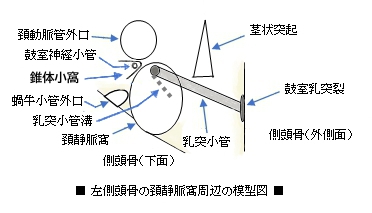
・「この窩の外側には細い乳突小管溝があり、まもなく骨中に入って乳突小管となり、後走して鼓室乳突裂に開き、迷走神経耳介枝を通す。また、頚静脈窩の前方で錐体後縁に沿って見られる三角形の小陥凹は(蝸牛小管)外口である。」(日本人体解剖学)

|
|

|
|
|
|
左側頭骨(下面) |
|
外頭蓋底
左頚静脈孔 |
右鼓室(斜め矢状断面) |
硬膜静脈洞 |
|
「 船戸和弥のHP 」では以下のように解説している。
「錐体下面の後縁に近い中部には弓状の大きく深い頚静脈窩がる。頚静脈上球を容れる。」
以下は「Wikipedia」の解説文となる。
The jugular fossa is a deep depression in the inferior part of the temporal bone at the base of the skull. It lodges the bulb of the internal jugular vein.
【Structure】
The jugular fossa is located in the temporal bone, posterior to the carotid canal and the cochlear aqueduct.
In the bony ridge dividing the carotid canal from the jugular fossa is the small inferior tympanic canaliculus for the passage of the tympanic branch of the glossopharyngeal nerve.
In the lateral part of the jugular fossa is the mastoid canaliculus for the entrance of the auricular branch of the vagus nerve.
Behind the jugular fossa is a quadrilateral area, the jugular surface, covered with cartilage in the fresh state, and articulating with the jugular process of the occipital bone.
【Variation】
The jugular fossa has variable depth and size in different skulls.
【Function】
The jugular fossa lodges the bulb of the internal jugular vein.
【 語 句 】
・depression:窪み ・temporal bone:側頭骨 ・internal jugular vein:内頚静脈 ・carotid canal:頚動脈管 ・cochlear aqueduct:外リンパ管 ・tympanic canaliculus:鼓室神経小管 ・glossopharyngeal nerve:舌咽神経 ・mastoid canaliculus:乳突小管 ・gagus nerve:迷走神経 ・quadrilateral:四辺形の ・cartilage:軟骨 ・in the fresh state:生体では ・articulate with ~:~と接合する ・occipital bone:後頭骨
■ 写真やイラストを掲載しているサイト ■
・ イラストや写真を掲載しているサイト-Ⅰ
・ イラストや写真を掲載しているサイト-Ⅱ
・ イラストや写真を掲載しているサイト-Ⅲ
・ イラストや写真を掲載しているサイト-Ⅳ
・ イラストや写真を掲載しているサイト-Ⅴ

|